2018 Hyundai Kona child restraint
[x] Cancel search: child restraintPage 54 of 523
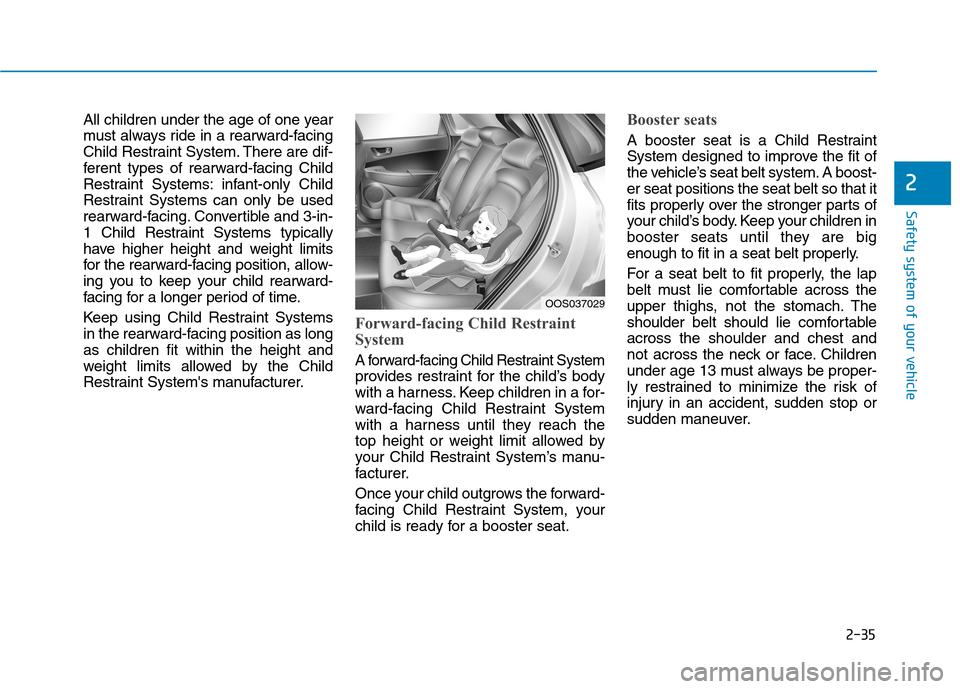
2-35
Safety system of your vehicle
2
All children under the age of one year
must always ride in a rearward-facing
Child Restraint System. There are dif-
ferent types of rearward-facing Child
Restraint Systems: infant-only Child
Restraint Systems can only be used
rearward-facing. Convertible and 3-in-
1 Child Restraint Systems typically
have higher height and weight limits
for the rearward-facing position, allow-
ing you to keep your child rearward-
facing for a longer period of time.
Keep using Child Restraint Systems
in the rearward-facing position as longas children fit within the height and
weight limits allowed by the Child
Restraint System's manufacturer.
Forward-facing Child Restraint
System
A forward-facing Child Restraint System
provides restraint for the child’s body
with a harness. Keep children in a for-
ward-facing Child Restraint System
with a harness until they reach the
top height or weight limit allowed by
your Child Restraint System’s manu-
facturer.
Once your child outgrows the forward-
facing Child Restraint System, your
child is ready for a booster seat.
Booster seats
A booster seat is a Child Restraint
System designed to improve the fit of
the vehicle’s seat belt system. A boost-er seat positions the seat belt so that it
fits properly over the stronger parts of
your child’s body. Keep your children in
booster seats until they are big
enough to fit in a seat belt properly.
For a seat belt to fit properly, the lap
belt must lie comfortable across the
upper thighs, not the stomach. The
shoulder belt should lie comfortableacross the shoulder and chest and
not across the neck or face. Children
under age 13 must always be proper-
ly restrained to minimize the risk of
injury in an accident, sudden stop or
sudden maneuver.
OOS037029
Page 55 of 523
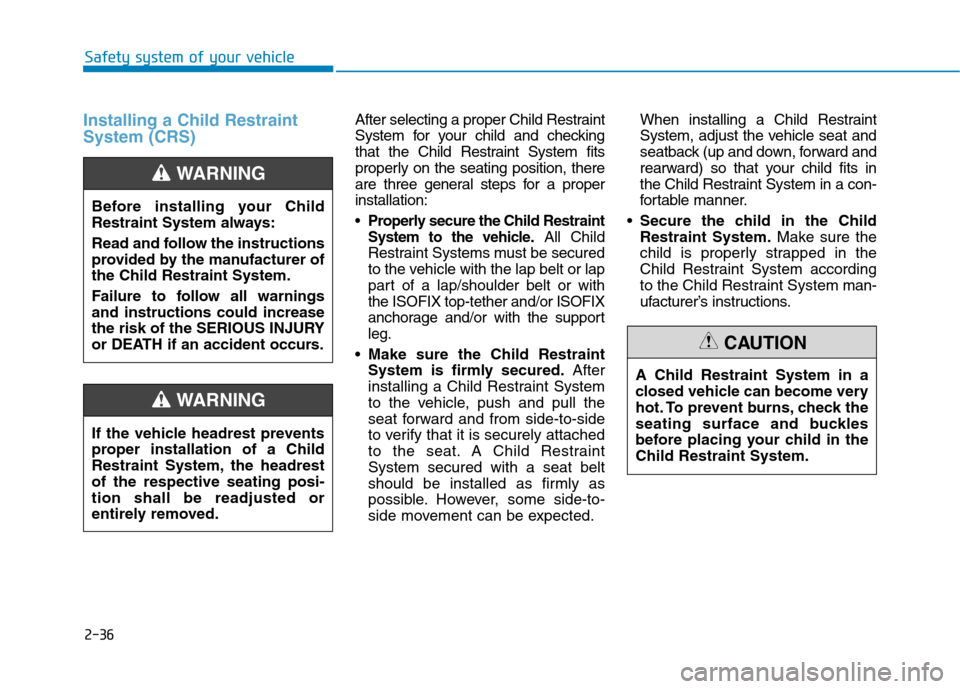
2-36
Safety system of your vehicle
Installing a Child Restraint System (CRS)After selecting a proper Child Restraint
System for your child and checking
that the Child Restraint System fits
properly on the seating position, there
are three general steps for a properinstallation:
Properly secure the Child Restraint
System to the vehicle.
All Child
Restraint Systems must be secured
to the vehicle with the lap belt or lap
part of a lap/shoulder belt or withthe ISOFIX top-tether and/or ISOFIX
anchorage and/or with the supportleg.
Make sure the Child Restraint
System is firmly secured. After
installing a Child Restraint System
to the vehicle, push and pull the
seat forward and from side-to-side
to verify that it is securely attached
to the seat. A Child RestraintSystem secured with a seat belt
should be installed as firmly as
possible. However, some side-to-
side movement can be expected. When installing a Child Restraint
System, adjust the vehicle seat and
seatback (up and down, forward and
rearward) so that your child fits in
the Child Restraint System in a con-
fortable manner.
Secure the child in the ChildRestraint System. Make sure the
child is properly strapped in the
Child Restraint System according
to the Child Restraint System man-
ufacturer’s instructions.
Before installing your Child
Restraint System always:
Read and follow the instructions
provided by the manufacturer ofthe Child Restraint System.
Failure to follow all warnings and instructions could increase
the risk of the SERIOUS INJURY
or DEATH if an accident occurs.
WARNING
If the vehicle headrest prevents
proper installation of a Child
Restraint System, the headrestof the respective seating posi-tion shall be readjusted or
entirely removed.
WARNING
A Child Restraint System in a
closed vehicle can become very
hot. To prevent burns, check the
seating surface and buckles
before placing your child in theChild Restraint System.
CAUTION
Page 56 of 523
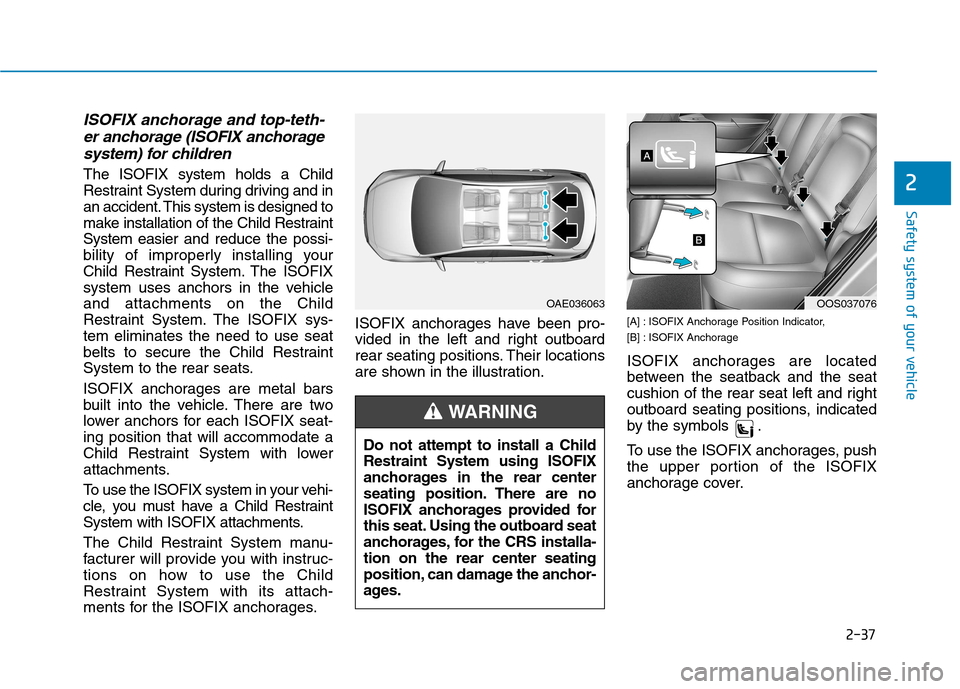
2-37
Safety system of your vehicle
2
ISOFIX anchorage and top-teth-er anchorage (ISOFIX anchorage
system) for children
The ISOFIX system holds a Child
Restraint System during driving and in
an accident. This system is designed to
make installation of the Child Restraint
System easier and reduce the possi-
bility of improperly installing your
Child Restraint System. The ISOFIX
system uses anchors in the vehicleand attachments on the Child
Restraint System. The ISOFIX sys-tem eliminates the need to use seat
belts to secure the Child Restraint
System to the rear seats.
ISOFIX anchorages are metal bars
built into the vehicle. There are two
lower anchors for each ISOFIX seat-ing position that will accommodate a
Child Restraint System with lower
attachments.
To use the ISOFIX system in your vehi-
cle, you must have a Child Restraint
System with ISOFIX attachments.
The Child Restraint System manu-
facturer will provide you with instruc-
tions on how to use the Child
Restraint System with its attach-
ments for the ISOFIX anchorages. ISOFIX anchorages have been pro-
vided in the left and right outboard
rear seating positions. Their locations
are shown in the illustration.
[A] : ISOFIX Anchorage Position Indicator,
[B] : ISOFIX Anchorage
ISOFIX anchorages are located
between the seatback and the seat
cushion of the rear seat left and right
outboard seating positions, indicated
by the symbols .
To use the ISOFIX anchorages, push
the upper portion
of the ISOFIX
anchorage cover.
OOS037076
Do not attempt to install a Child Restraint System using ISOFIX
anchorages in the rear center
seating position. There are no
ISOFIX anchorages provided for
this seat. Using the outboard seat
anchorages, for the CRS installa-tion on the rear center seating
position, can damage the anchor-
ages.
WARNING
OAE036063
Page 57 of 523
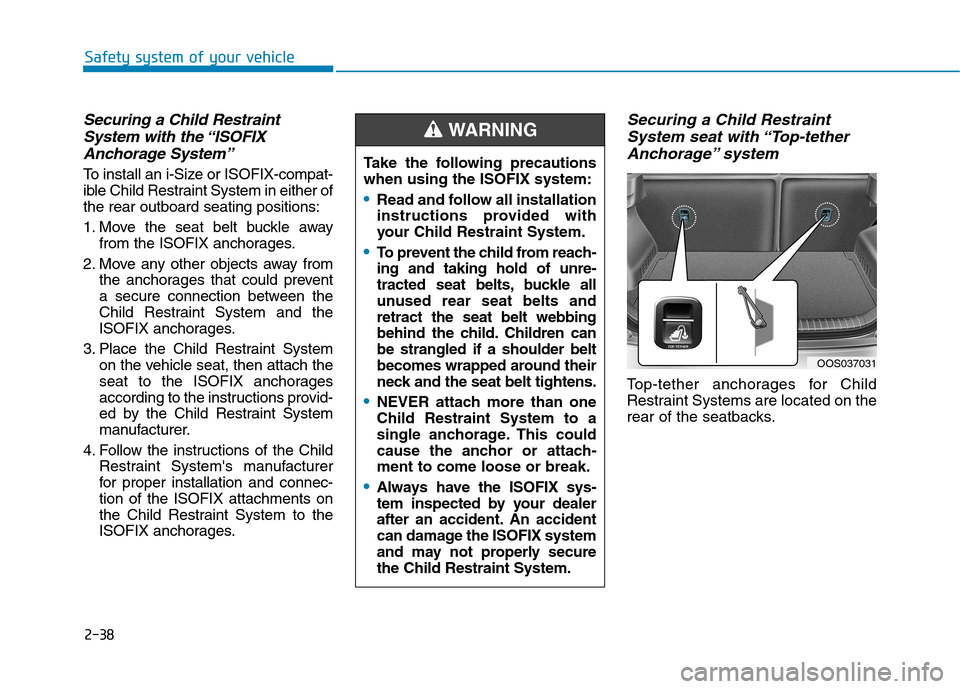
2-38
Safety system of your vehicle
Securing a Child RestraintSystem with the “ISOFIX
Anchorage System”
To install an i-Size or ISOFIX-compat-
ible Child Restraint System in either ofthe rear outboard seating positions:
1. Move the seat belt buckle away from the ISOFIX anchorages.
2. Move any other objects away from the anchorages that could prevent
a secure connection between the
Child Restraint System and the
ISOFIX anchorages.
3. Place the Child Restraint System on the vehicle seat, then attach the
seat to the ISOFIX anchorages
according to the instructions provid-
ed by the Child Restraint System
manufacturer.
4. Follow the instructions of the Child Restraint System's manufacturer
for proper installation and connec-tion of the ISOFIX attachments on
the Child Restraint System to the
ISOFIX anchorages.
Securing a Child Restraint
System seat with “Top-tether
Anchorage” system
Top-tether anchorages for Child
Restraint Systems are located on the
rear of the seatbacks.
Take the following precautionswhen using the ISOFIX system:
Read and follow all installation
instructions provided with
your Child Restraint System.
To prevent the child from reach- ing and taking hold of unre-
tracted seat belts, buckle all
unused rear seat belts andretract the seat belt webbing
behind the child. Children canbe strangled if a shoulder belt
becomes wrapped around their
neck and the seat belt tightens.
NEVER attach more than one Child Restraint System to a
single anchorage. This could
cause the anchor or attach-ment to come loose or break.
Always have the ISOFIX sys-
tem inspected by your dealer
after an accident. An accident
can damage the ISOFIX system
and may not properly securethe Child Restraint System.
WARNING
OOS037031
Page 58 of 523
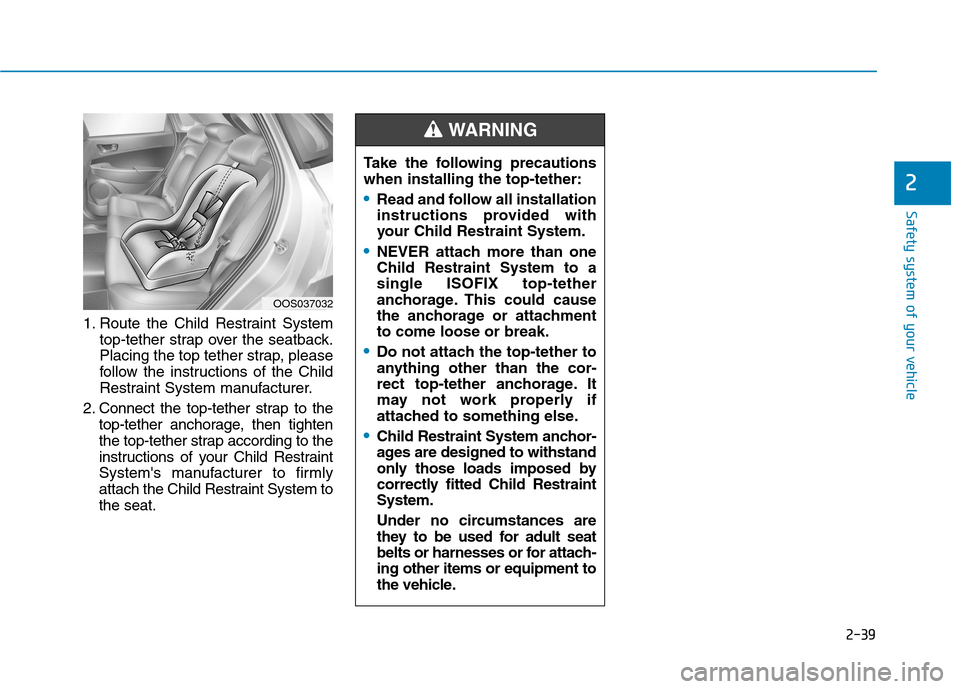
2-39
Safety system of your vehicle
2
1. Route the Child Restraint Systemtop-tether strap over the seatback.
Placing the top tether strap, please
follow the instructions of the Child
Restraint System manufacturer.
2. Connect the top-tether strap to the top-tether anchorage, then tighten
the top-tether strap according to the
instructions of your Child Restraint
System's manufacturer to firmly
attach the Child Restraint System tothe seat.
OOS037032 Take the following precautions when installing the top-tether:
Read and follow all installation
instructions provided with
your Child Restraint System.
NEVER attach more than one Child Restraint System to asingle ISOFIX top-tether
anchorage. This could cause
the anchorage or attachmentto come loose or break.
Do not attach the top-tether to
anything other than the cor-
rect top-tether anchorage. It
may not work properly if
attached to something else.
Child Restraint System anchor-
ages are designed to withstand
only those loads imposed by
correctly fitted Child RestraintSystem.
Under no circumstances are
they to be used for adult seat
belts or harnesses or for attach-ing other items or equipment to
the vehicle.
WARNING
Page 59 of 523
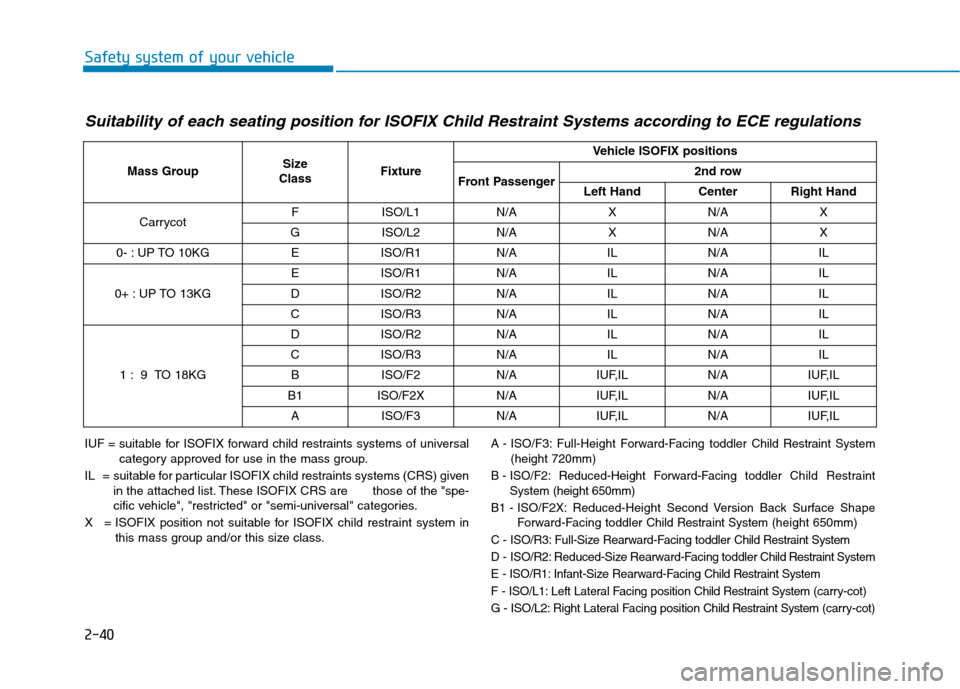
2-40
Safety system of your vehicle
Suitability of each seating position for ISOFIX Child Restraint Systems according to ECE regulations
IUF = suitable for ISOFIX forward child restraints systems of universalcategory approved for use in the mass group.
IL = suitable for particular ISOFIX child restraints systems (CRS) given in the attached list. These ISOFIX CRS are those of the "spe-
cific vehicle", "restricted" or "semi-universal" categories.
X = ISOFIX position not suitable for ISOFIX child restraint system in this mass group and/or this size class.A - ISO/F3: Full-Height Forward-Facing toddler Child Restraint System
(height 720mm)
B - ISO/F2: Reduced-Height Forward-Facing toddler Child Restraint
System (height 650mm)
B1 - ISO/F2X: Reduced-Height Second Version Back Surface Shape Forward-Facing toddler Child Restraint System(height 650mm)
C - ISO/R3: Full-Size Rearward-Facing toddler Child Restraint System
D - ISO/R2: Reduced-Size Rearward-Facing toddler Child Restraint System
E - ISO/R1: Infant-Size Rearward-Facing Child Restraint System
F - ISO/L1: Left Lateral Facing position Child Restraint System(carry-cot)
G - ISO/L2: Right Lateral Facing position Child Restraint System (carry-cot)
Mass GroupSize
ClassFixture
Vehicle ISOFIX positions
Front Passenger2nd row
Left HandCenterRight Hand
CarrycotFISO/L1N/AXN/AX
GISO/L2N/AXN/AX
0- : UP TO 10KGEISO/R1N/AILN/AIL
0+ : UP TO 13KG
EISO/R1N/AILN/AIL
DISO/R2N/AILN/AIL
CISO/R3N/AILN/AIL
1 : 9 TO 18KG
DISO/R2N/AILN/AIL
CISO/R3N/AILN/AIL
BISO/F2N/AIUF,ILN/AIUF,IL
B1ISO/F2XN/AIUF,ILN/AIUF,IL
AISO/F3N/AIUF,ILN/AIUF,IL
Page 60 of 523
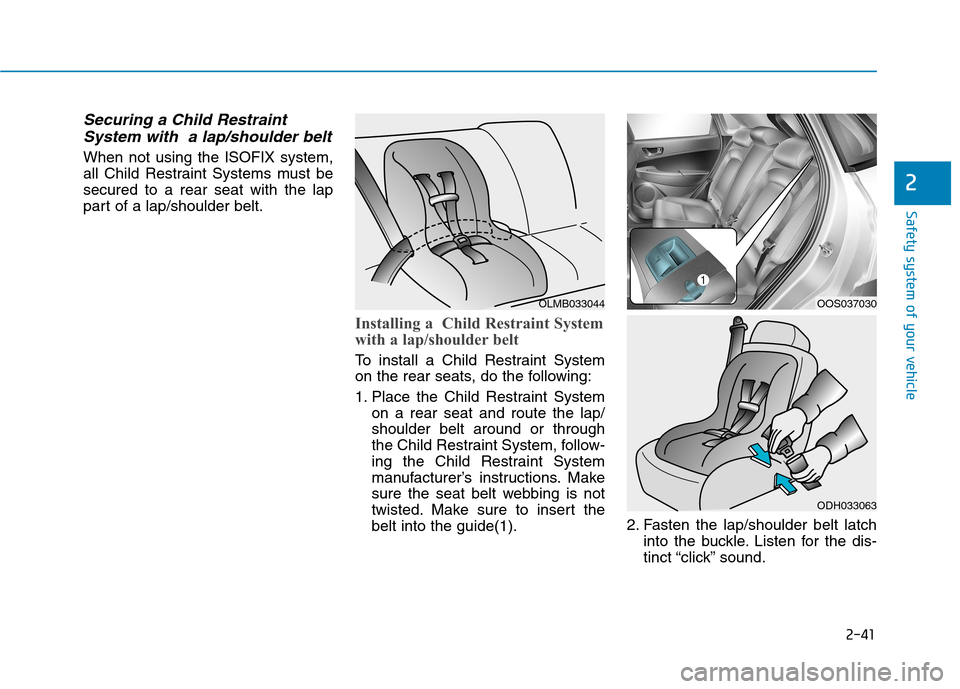
2-41
Safety system of your vehicle
2
Securing a Child RestraintSystem with a lap/shoulder belt
When not using the ISOFIX system,
all Child Restraint Systems must besecured to a rear seat with the lap
part of a lap/shoulder belt.
Installing a Child Restraint System
with a lap/shoulder belt
To install a Child Restraint System
on the rear seats, do the following:
1. Place the Child Restraint System on a rear seat and route the lap/ shoulder belt around or through
the Child Restraint System, follow-
ing the Child Restraint System
manufacturer’s instructions. Make
sure the seat belt webbing is not
twisted. Make sure to insert thebelt into the guide(1). 2. Fasten the lap/shoulder belt latch
into the buckle. Listen for the dis-
tinct “click” sound.
OLMB033044OOS037030
ODH033063
Page 61 of 523
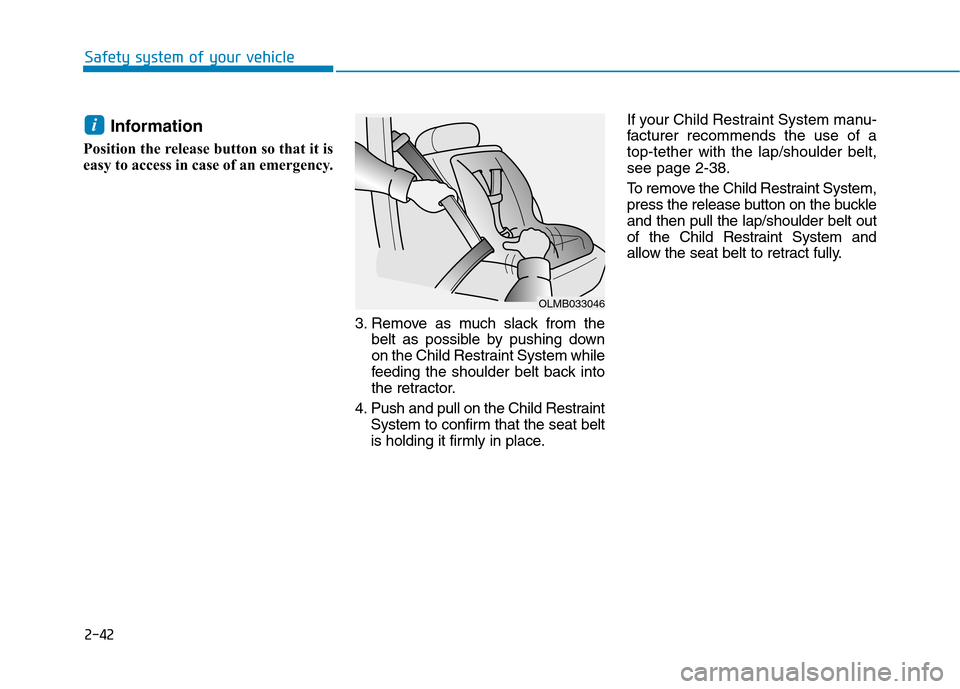
2-42
Safety system of your vehicle
Information
Position the release button so that it is
easy to access in case of an emergency.
3. Remove as much slack from thebelt as possible by pushing down
on the Child Restraint System while
feeding the shoulder belt back into
the retractor.
4. Push and pull on the Child Restraint System to confirm that the seat belt
is holding it firmly in place. If your Child Restraint System manu-
facturer recommends the use of atop-tether with the lap/shoulder belt,see page 2-38.
To remove the Child Restraint System,
press the release button on the buckleand then pull the lap/shoulder belt out
of the Child Restraint System and
allow the seat belt to retract fully.i
OLMB033046